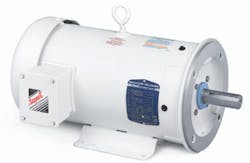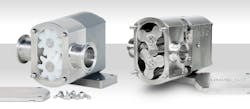‘Motor coalition’ asks DOE to reconsider proposed energy efficiency rating change
Unless simply tired of the subject, almost anyone would agree that in the 21st century energy efficiency is a matter of considerable importance to the process industries. But, as per usual, how to get from here to there can quickly become a matter of heated debate.
Groups including the American Council for an Energy-Efficient Economy (ACEEE), the Appliance Standards Awareness Project (ASAP), the Natural Resources Defense Council and National Electrical Manufacturers Association (NEMA) motor section members, which include major electric-motor suppliers, are petitioning the Department of Energy (DOE) to reconsider its intention to mandate an increase of about 0.4 to 1.5% from the current levels for nominal motor efficiency for 1- to 500-hp motors.
Instead, these important stakeholders would like to see the DOE keep ratings where they are, at "premium" efficiency levels, but apply them to a wider range of 1- to 500-hp motors.
In terms of energy efficiency, the issue is an important one.
The Leadership in Energy and Environmental Design Certification program, for example, includes many sound recommendations for energy-efficient practices related to building and grounds design, lighting, water usage and other parameters. But, relatively speaking, that is all small beer. Process loads dominate the energy discussion in industrial plants.
It’s estimated that electric motors account for approximately 60% of electricity consumption in industrial applications. Moreover, globally, each year sees shipment of about 1.6 million electric motors that, among other things, drive pumps, fans, blowers and compressors.
Devilish details
Current energy conservation standards for electric motors established by the Energy Independence and Security Act of 2007 (EISA) cover subtype I and subtype II general-purpose electric motors of 1- to 200-hp, fire-pump motors of 1- to 500-hp, and NEMA Design B general-purpose electric motors of 200- to 500-hp.
The DOE is at present conducting a technical study on "medium" AC induction motors of 1- to 500-hp. In its study, the DOE has been evaluating a possible increase in nominal motor efficiency of 1 – 3 NEMA bands, which translates into approximately 0.4 to 1.5% above NEMA Premium Efficiency levels as defined in MG 1-2011 table 12-12.
Technology options mentioned by the DOE for meeting the standard include improved bearings, a more efficient cooling system, improved grades of electrical steel and using thinner steel laminations.
But it’s even more complex than that, says John Malinowski, senior product manager for AC motors, Baldor Electric Co., "A motor redesign might be necessary. That could entail new laminations, winding equipment and in many cases, new frames to fit the extra material. For users and OEMs, designs may not fit where existing motor designs of the same ratings fit today."
For the makers of electric motors, the costs of the retooling involved, Malinowski says, could run into "hundreds of millions of dollars," and this just after the industry has spent years building up its volume capacity in the wake of the EISA, which came into effect in 2010.
Moreover, within the huge installed base of motors, end-users may have trouble fitting a new higher-efficiency replacement motor into their equipment or existing process-system footprint.
A united front
In response, a petition to adopt NEMA MG 1 table 12-12 for an expanded scope of 1- to 500-hp motors, many of which were not previously covered by the DOE, was proposed October 2010 for adoption in place of the DOE’s technical study, which essentially was a working draft of the new proposed rule.
The petitioners included NEMA motor section members and energy-advocate groups, some of which have already been mentioned. These include ACEEE, Alliance to Save Energy, ASAP, Earthjustice, NRDC, Northwest Energy Efficiency Alliance, Northeast Energy Efficiency Partnerships and Northwest Power and Conservation Council.
This so-called "motor coalition" says their proposed way of doing things will bring greater energy-efficiency benefits to bear, without incurring the tremendous expense that will follow, should the present DOE proposed rule become final.
The 2012 ASAP/ACEEE report, The Efficiency Boom, analyzed a standard levels which included an increase to the NEMA Premium levels for most of the few categories of currently covered motors subject to lower standards. However, ASAP says, the lion’s share of the benefits derive from an expanded scope of coverage to include products not previously subject to standards. The average estimated per-unit savings are about 2%, with an incremental cost that varies based on motor size. Typical payback periods are about four years.
The statutory deadline for the final rule was December of 2012, which the DOE missed. That may be a good thing. Malinowski says further interviews with motor manufacturers were conducted in early 2013 and the result is now expected to be circulated before the end of this year. This will allow for further comments from interested parties. The final rule should issue in 2014, with the regulations in effect in 2017.
The petitioners are said to remain optimistic that the DOE will adopt their proposal as a final rule, avoiding what Malinowski and others say would be a tremendous imposition to U.S. motor users and equipment makers.
The United States has had efficiency regulations for industrial electric motors in place since the Energy Policy Act of 1992 went into effect in October, 1997. Normal practice is that Canada and Mexico have followed with regulations that basically mirror what is done in the U.S.


